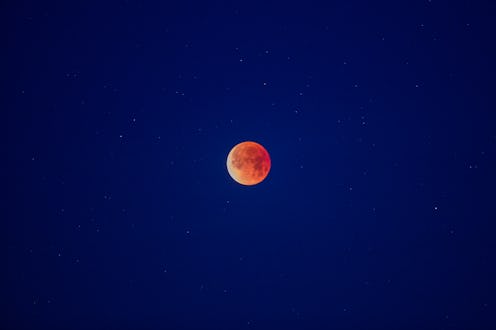
At this point in the month, you've almost definitely heard the hype going on about July's full moon. That's because it isn't just any full moon: it's a total lunar eclipse, the longest one of the 21st century at one hour and 43 minutes, and it's happening during Mercury retrograde and Leo season. So, yes, it's a pretty big deal. There's so much going on, actually, that's it easy to get confused about all of the different astrological terms. You may have heard this full moon being called a total lunar eclipse and a blood moon — so which one is it? It's actually both, and the reason why it's called a blood moon is pretty interesting.
A total lunar eclipse and a blood moon are essentially the same thing with slightly different meanings. A total lunar eclipse refers to the moment when the Earth puts itself directly in between the sun and the moon. As the moon, the Earth, and the sun directly line up, the Earth blocks the moon from the sun, casting a shadow over the entire moon. So when one says "total lunar eclipse," they are referring to this astrological phenomenon.
A blood moon, however, refers to the way the moon looks because of the total lunar eclipse. The term "blood moon" came about because of the appearance of the moon. When a full moon is full eclipsed, it has a reddish-brown color to it. You may be thinking to yourself, "But you just said that the Earth is blocking all of the sun's light from the moon... how does it have any color to it?" Good point! Here's the thing, though: as the moon travels through the Earth's umbra (the dark center portion of a shadow), a teensy bit of sunlight will still reach the lunar surface indirectly through the Earth's atmosphere. The light waves are stretched out, and so they look red - and when they hit the moon's surface, they still look red. That reddish-brown color looks similar to blood, hence the name.
As Space.com points out, "how red the moon appears can depend on how much pollution, cloud cover or debris there is in the atmosphere." So even during this upcoming full lunar eclipse, we're not guaranteed to see a blood moon that lives up to its name.
The term "blood moon" is actually not scientific at all, and has no real meaning in the science world. It's basically just a term someone made up to describe the moon and it stuck. The name doesn't hold any significance, and if you use it, most people will know you're just talking about a total lunar eclipse.
That said, this July's blood moon is certainly going to be a special one, and if you're lucky enough to live in an area where you can see it, you should take advantage of that. Unfortunately, the eclipse will not be visible in North America - instead, you'll be able to see it in Asia, Africa, Australia, and parts of Europe and South America.